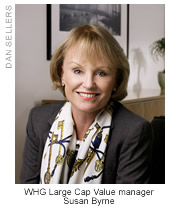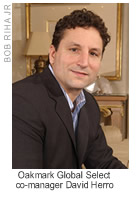Best of the New Funds
With experienced managers in charge, you needn't sweat the lack of track records.
The fund industry bombards us weekly with newly launched funds. Is there ever a reason to invest in a rookie? As it turns out, there is.
Managers of fresh funds can invest in their most promising picks without having to contend with the baggage of existing holdings. Steve Rogé, a fund manager and financial adviser, gives this example: Suppose a fund bought a stock three years ago because the manager thought it was undervalued by 30%. The stock rose and today is only 10% undervalued. If the manager were starting from scratch, he or she probably wouldn't buy that stock now. But a manager who already owned the shares would probably hang on to them because the stock is not yet overvalued and selling would generate a taxable capital gain.
Moreover, new funds are usually small, and smaller funds are more nimble and flexible, which allows them to enter and exit positions without tipping off the market. Richard Evans, a finance professor at Boston College, compared the impact that funds with small and large asset bases have on stock prices when they trade in and out of shares. He and a couple of colleagues concluded that large funds have twice the impact -- more than 0.2 percentage point -- when they buy and sell, and the extra cost hurts their performance.

Sign up for Kiplinger’s Free E-Newsletters
Profit and prosper with the best of expert advice on investing, taxes, retirement, personal finance and more - straight to your e-mail.
Profit and prosper with the best of expert advice - straight to your e-mail.
We're not saying that you should purchase just any new fund. The seven clean slates we profile here are all run by skilled managers at reputable fund companies.
A cheaper model
When does a new fund come with a track record? When it's a clone of an existing fund. Such is the case with WHG Large Cap Value (WHGLX), which is identical to Westwood Equity fund, ably run by Susan Byrne for 20 years. Over the past ten years, Westwood gained 9% annualized, beating Standard & Poor's 500-stock index by an average of nearly two percentage points per year (all performance data are to February 1). But the WHG fund comes with a significantly lower expense ratio (1% annually, compared with the older fund's 1.5%).

These days, Dallas-based Byrne says she's finding value in high-quality businesses, such as IBM and Automatic Data Processing. Their value measures are usually well above the overall market's, but that is not the case today. Further illustrating that the distinction between growth and value has blurred, Byrne says she's seeing value in growth stocks.
Her growth favorites are those that sell their products to an expanding market. She loves United Technologies, which makes elevators, aircraft engines and commercial air-conditioning units -- products in great demand in developing countries, such as China, that are rapidly building infrastructure. In the consumer arena, she favors Colgate-Palmolive, which generates most of its revenues overseas.
Dividends from abroad
What do a Hong Kong bank, a Taiwanese chip maker, a Japanese convenience-store chain and an Australian soft-drink bottler have in common? All four -- HSBC, Taiwan Semiconductor, Lawson and Coca-Cola Amatil -- regularly boost their dividends, and all are held by Matthews Asia Pacific Equity Income (MAPIX), a new offering from a firm that specializes in Asian funds.
The principle of looking for companies that regularly increase their dividends to identify attractive stocks is no different in Asia than in the U.S. Dividend growers generally produce steadily rising cash flow and possess strong balance sheets (see The Lure of Rising Dividends). One difference, though, is that those dividends are denominated in foreign currencies. Given the limp greenback, that's not a bad thing (money in foreign currencies gets translated into more dollars when the buck weakens).
Andrew Foster, who runs the new Matthews fund, says Asian companies have been boosting the percentage of profits they pay out as dividends. "In the past, Japanese executives didn't even know their companies' payout ratio," he says. That's changed. Large, state-owned Chinese enterprises, by contrast, do have a tradition of paying dividends -- to the Beijing government. Today, these outfits are going public and paying dividends to shareholders, which led Foster to invest in Chinese dividend payers such as Huaneng Power International, a big power generator.
[page break]
Marriage of distinction
Two value-investing luminaries join forces at Oakmark Global Select (OAKWX). Bill Nygren, who manages Oakmark fund and Oakmark Select, picks the U.S. stocks for this concentrated global fund. David Herro, the manager of Oakmark International, selects the foreign stocks. Both employ Oakmark's trademark value-oriented approach to stock picking.

Nygren explains the genesis of the fund idea this way: "David and I realized that the themes we were talking about in each of our markets had a very large overlap." For example, the duo think that large-company stocks, which have lagged in recent years, were undervalued relative to the shares of small and midsize companies both here and abroad. And many of the best firms, U.S. or foreign, are capable of competing strongly across the globe.
At last word, the fund's 20 stocks were evenly split between U.S. and foreign companies. One big holding was McDonald's, which Nygren likes because of its powerful global presence and brand, especially in emerging nations such as China. Viacom, owner of MTV and Nickelodeon, is another top holding. Nygren says that the Internet, iPods and other technologies will expand outlets for Viacom's content at home and abroad. Two large foreign holdings are GlaxoSmithKline, a drug maker based in England, and British Sky Broadcasting, Rupert Murdoch's European satellite broadcaster.
Cage rattler
Most bargain-hunting managers invest in downtrodden companies and wait for other investors to bid up the stocks to their true value. Bob Olstein's new fund, Olstein Strategic Opportunities (OFSCX), takes a different tack. Rather than sit on the sidelines, the veteran fund manager plans to flex his muscle as a shareholder -- and push his own recommendations for improvement.
Olstein's rabble-rousing roots go back four decades. The cocky New Yorker has built a career picking apart company balance sheets and rooting out financial chicanery -- first as an independent stock researcher, and later as a fund manager. As the manager of Olstein All Cap Value (formerly Olstein Financial Alert), he's made gobs of money for shareholders. The fund gained 16% annualized from its 1995 inception, beating the S&P 500 by an average of 5.5 percentage points a year.
For the new fund, Olstein and co-manager Eric Heyman plan to take large positions in small and midsize firms that have suffered short-term setbacks. "We look for companies whose managements we think are not moving in the right direction and that have a high probability of listening to us," says Olstein. Then they begin rattling cages. This might mean pushing for new leadership, for a change in strategy or for selling off assets. Using this approach, Olstein has promoted changes in some of All Cap Value's holdings, including Jo-Ann Stores and RadioShack.
The new fund, Strategic Opportunities, charges steep annual fees of 2.35%. An expense ratio that high is a big hurdle to overcome. Still, Olstein's performance over the years with his older fund suggests that he may be worth the price.
[page break]
High-yielding mishmash
Great ideas are often lost as managers aim to stay true to a fund's investing style. Take, for example, the problem that managers at Tom Marsico's Denver fund shop encountered: "We kept finding opportunities that didn't fit into any of our funds," says Cory Gilchrist, one of the firm's portfolio managers. "We'd get off a conference call and one of us would say, 'I wish I could buy that for my personal account.' " They couldn't because Marsico forbids employees from owning individual stocks. But it made a lot of sense to create a fund that could invest in these leftovers, and so Marsico Flexible Capital (MFCFX) was born.
Flexible Capital is the odd duck of the Marsico family, which is known for its expertise in growth stocks. The $20-million fund has 12% of assets in junk bonds and the rest in 22 mostly high-yielding stocks. The companies don't easily fit into growth or value portfolios, but many are mispriced, says Gilchrist, who runs Flexible Capital as well as Marsico 21st Century, a large-company growth fund that returned an annualized 25% since he took over in February 2003.
A key theme in the new fund's portfolio is inflation protection. For example, it holds shares of Transurban, an Australian company that builds and operates toll roads throughout the world. Transurban's contracts call for 4% to 4.5% price increases for inflation. The fund also holds a few real estate investment trusts that own apartments. This unusual collection of securities results in a portfolio that recently yielded 4.1%, after annual expenses of 1.6%.
Thriving threesome
Like cabernet sauvignon and bittersweet chocolate, some combinations are made for one another. Take Scott Satterwhite, Jim Kieffer and George Sertl, the team that runs Artisan Opportunistic Value (ARTLX). For the better part of the decade, the threesome have steered Artisan Small Cap Value and Artisan Mid Cap Value. Over the past five years, Small Cap returned 17% annualized and Mid Cap returned 18%. Both are now shut to new investors.
The trio seeks cash-rich companies that trade at bargain prices. "We generally find value where there are low expectations," says Satterwhite. "The best buys are financially strong companies that may have disappointed investors in the short term but don't have deep-running problems."
Launched in March 2006, Opportunistic Value is the first Artisan fund with the ability to focus on large domestic companies (although it may also buy midsize firms and invest up to 25% of its assets overseas). The fund holds 30 to 40 stocks, and the managers can invest up to 10% of assets in one stock. Oil-and-gas producer Apache recently held the top spot, accounting for more than 5% of assets.
Overseas middle ground
The latest addition to T. Rowe Price's lineup aims to fill the gap between the firm's value-oriented and growth-focused international funds. T. Rowe Price Overseas Stock (TROSX) invests mostly in large companies in developed markets that blend growth and value characteristics. An example is Swiss drug giant Novartis, which manager Raymond Mills expects to deliver annual earnings growth of 15% over the next few years. "The company isn't a screaming value in the absolute sense, but it's also not terribly expensive relative to its history," says Mills. The fund has about two-thirds of assets in Western European stocks, 20% in Japanese names and a sliver in emerging-markets stocks.
Mills, who has run money for Price's institutional clients since 2000, has built a terrific record managing the firm's value-focused International Growth & Income fund. Over the past five years, Growth & Income returned 19% annualized, beating the typical diversified overseas fund by an average of four percentage points per year. The new fund charges a relatively modest 1.15% a year for expenses.
Key data: New funds with promise
By definition, new funds don't have records. But the managers of the seven funds on our list have compiled solid records running other funds.
| COMPANY | SYMBOL | EXPENSE RATIO | MINIMUM INVESTMENT | TOLL-FREE NUMBER |
| Artisan Opportunistic Value | ARTLX | 1.64% | $1,000 | 800-344-1770 |
| Marsico Flexible Capital | MFCFX | 1.60 | 2,500 | 888-860-8686 |
| Matthews Asia Pacific Eq Inc | MAPIX | 1.47 | 2,500 | 800-789-2742 |
| Oakmark Global Select | OAKWX | 1.75 | 1,000 | 800-625-6275 |
| Olstein Strategic Opp C | OFSCX | 2.35 | 1,000 | 800-799-2113 |
| T. Rowe Price Overseas Stock | TROSX | 1.15 | 2,500 | 800-541-6066 |
| WHG Large Cap Value | WHGLX | 1.00 | 5,000 | 877-386-3944 |
Sources: Fund companies.
Get Kiplinger Today newsletter — free
Profit and prosper with the best of Kiplinger's advice on investing, taxes, retirement, personal finance and much more. Delivered daily. Enter your email in the box and click Sign Me Up.
-
 Married? Five Ways to Ensure Your Estate Plans Work in Tandem
Married? Five Ways to Ensure Your Estate Plans Work in TandemGetting on the same page now means fewer potential problems when it counts.
By Kiplinger Advisor Collective
-
 12 Investments No Retiree Should Make
12 Investments No Retiree Should MakeIn retirement, when it's wise to take fewer risks with your nest egg, some investments are just nuts.
By David Rodeck
-
 Best Banks for High-Net-Worth Clients
Best Banks for High-Net-Worth Clientswealth management These banks welcome customers who keep high balances in deposit and investment accounts, showering them with fee breaks and access to financial-planning services.
By Lisa Gerstner
-
 Stock Market Holidays in 2025: NYSE, NASDAQ and Wall Street Holidays
Stock Market Holidays in 2025: NYSE, NASDAQ and Wall Street HolidaysMarkets When are the stock market holidays? Here, we look at which days the NYSE, Nasdaq and bond markets are off in 2025.
By Kyle Woodley
-
 Stock Market Trading Hours: What Time Is the Stock Market Open Today?
Stock Market Trading Hours: What Time Is the Stock Market Open Today?Markets When does the market open? While the stock market does have regular hours, trading doesn't necessarily stop when the major exchanges close.
By Michael DeSenne
-
 Bogleheads Stay the Course
Bogleheads Stay the CourseBears and market volatility don’t scare these die-hard Vanguard investors.
By Kim Clark
-
 The Current I-Bond Rate Until May Is Mildly Attractive. Here's Why.
The Current I-Bond Rate Until May Is Mildly Attractive. Here's Why.Investing for Income The current I-bond rate is active until November 2024 and presents an attractive value, if not as attractive as in the recent past.
By David Muhlbaum
-
 What Are I-Bonds? Inflation Made Them Popular. What Now?
What Are I-Bonds? Inflation Made Them Popular. What Now?savings bonds Inflation has made Series I savings bonds, known as I-bonds, enormously popular with risk-averse investors. So how do they work?
By Lisa Gerstner
-
 This New Sustainable ETF’s Pitch? Give Back Profits.
This New Sustainable ETF’s Pitch? Give Back Profits.investing Newday’s ETF partners with UNICEF and other groups.
By Ellen Kennedy
-
 As the Market Falls, New Retirees Need a Plan
As the Market Falls, New Retirees Need a Planretirement If you’re in the early stages of your retirement, you’re likely in a rough spot watching your portfolio shrink. We have some strategies to make the best of things.
By David Rodeck